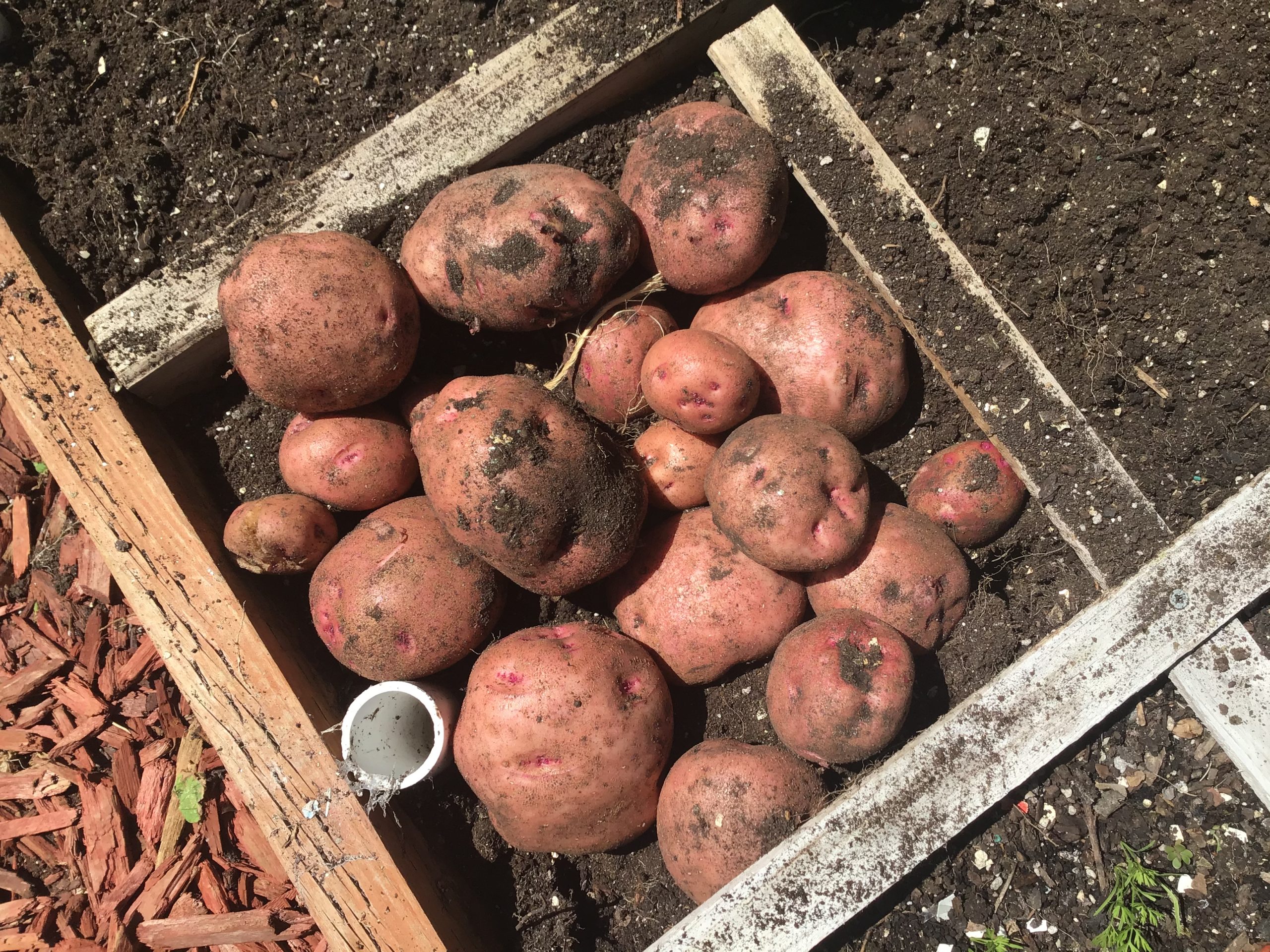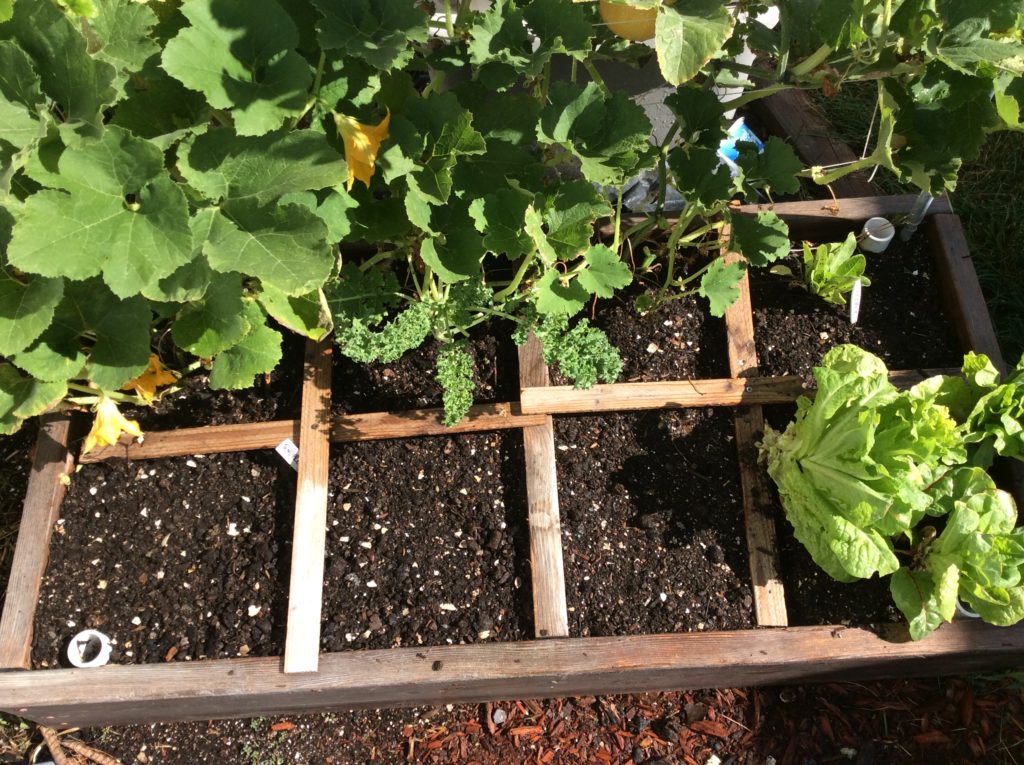 There’s very few pest problems in the square foot garden. I do have issues with snails and slugs because of the many greens I grow year round. I have methods to take care of those and they work, but it does take a little bit of time. Truth be told, I spend more time controlling slugs than I do weeding. The basic rotation of root/fruit/leaf is not only a good way to get lots of variety, but its a great way to cut down or eliminate garden pests. I had radishes (root) in the front squares during the early spring, followed immediately by transplanted lettuce(leaf), and now beans(fruit). No bug issues here! Growing in the back of the box is my favorite variety of spaghetti squash. And there’s lots of them!
There’s very few pest problems in the square foot garden. I do have issues with snails and slugs because of the many greens I grow year round. I have methods to take care of those and they work, but it does take a little bit of time. Truth be told, I spend more time controlling slugs than I do weeding. The basic rotation of root/fruit/leaf is not only a good way to get lots of variety, but its a great way to cut down or eliminate garden pests. I had radishes (root) in the front squares during the early spring, followed immediately by transplanted lettuce(leaf), and now beans(fruit). No bug issues here! Growing in the back of the box is my favorite variety of spaghetti squash. And there’s lots of them!
Growing zucchini vertically in 1 square foot
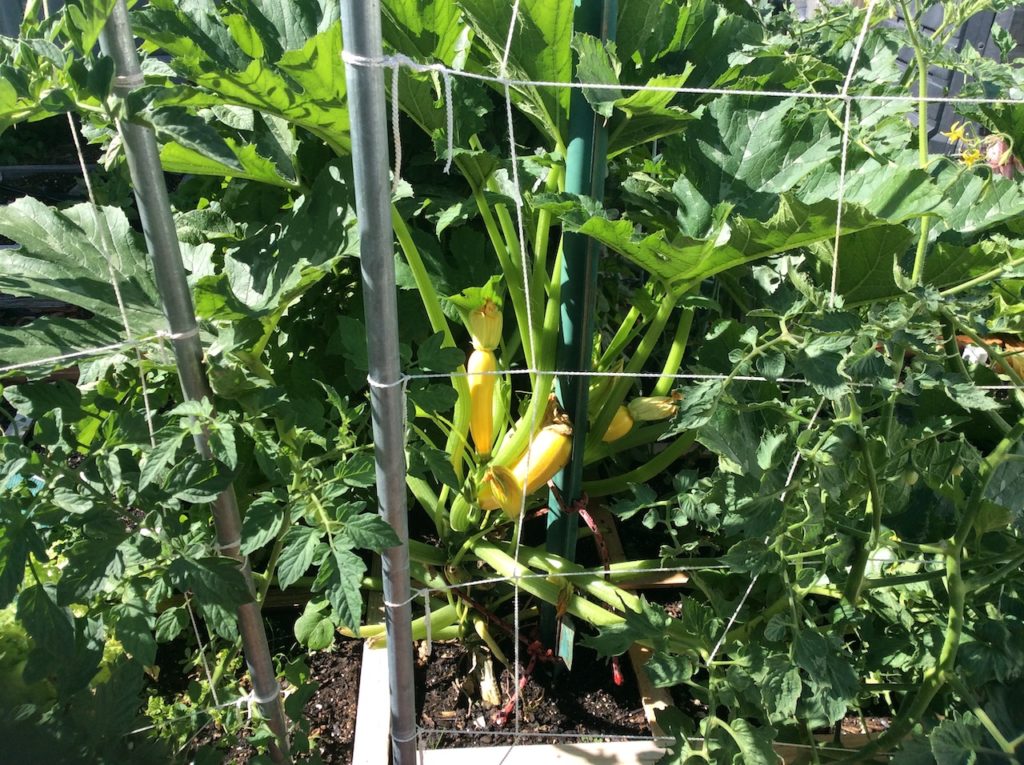 We all know how much space one zucchini plant can take up. Ive been growing mine vertically with a t-post and a jumprope for years. If you’ve been to even my beginners square foot gardening classes you know how it’s done. It also helps you to harvest zucchini at the proper stage by not letting it get too big. This is sandwiched next to 2 tomato plants, a cantaloupe plant, basil, parsley, potatoes and beans. Everything grows in the square foot garden while being really efficient.
We all know how much space one zucchini plant can take up. Ive been growing mine vertically with a t-post and a jumprope for years. If you’ve been to even my beginners square foot gardening classes you know how it’s done. It also helps you to harvest zucchini at the proper stage by not letting it get too big. This is sandwiched next to 2 tomato plants, a cantaloupe plant, basil, parsley, potatoes and beans. Everything grows in the square foot garden while being really efficient.
Thinking about the winter square foot garden
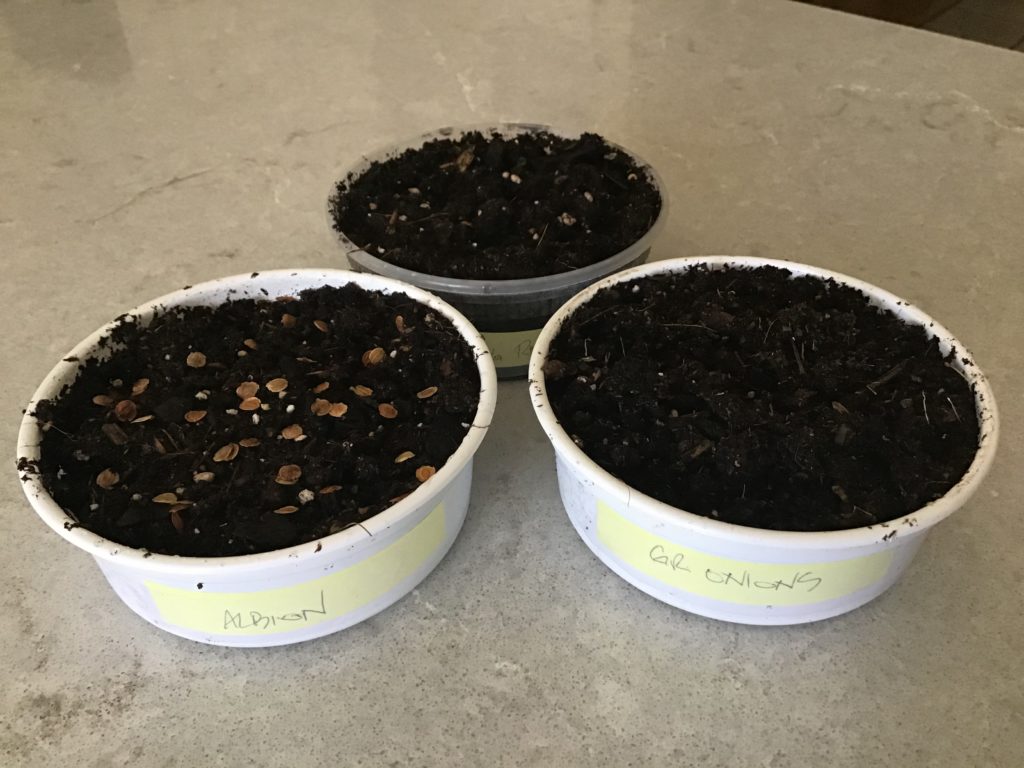 Here it is-almost the second week into July and we’r already talking winter. Though lots of fun summer harvesting is still ahead, it’s time to think about what needs to go into the winter garden. In a few weeks it’ll be too late to think about crops such as leeks, and green onions. You certainly won’t be able to find them in the nurseries around here. And what ever happened to parsnips? Nobody grows them anymore! If you’ve not tried them you should. They are so good in the winter garden as the colder temperatures make them very sweet. I’ve always started these three crops this way. The reason? I’m not telling yet. But you’ll see when they are harvested. You can grow them better than anything you’ll find at the market.
Here it is-almost the second week into July and we’r already talking winter. Though lots of fun summer harvesting is still ahead, it’s time to think about what needs to go into the winter garden. In a few weeks it’ll be too late to think about crops such as leeks, and green onions. You certainly won’t be able to find them in the nurseries around here. And what ever happened to parsnips? Nobody grows them anymore! If you’ve not tried them you should. They are so good in the winter garden as the colder temperatures make them very sweet. I’ve always started these three crops this way. The reason? I’m not telling yet. But you’ll see when they are harvested. You can grow them better than anything you’ll find at the market.
I’ll have a few gardening classes coming up for those interested. The first couple will be the fall square foot gardening class. Immediately after that will be the square foot garden winter classes, complete with how to build protection, what crops do well here, and when to plant. These are both done at my home in a very comfortable setting where you learn how to do it.
Come Labor day when most people start thinking it’s time to close the garden, yours will be up and producing a huge harvest. Stay tuned.
Vertical growing in the square foot garden
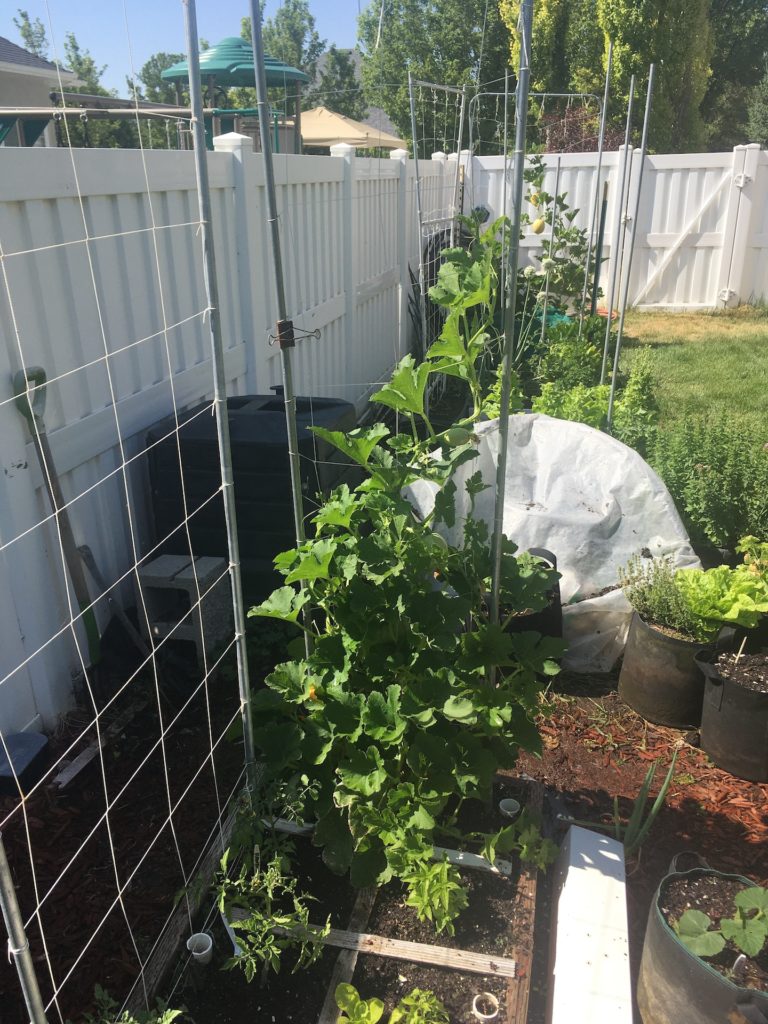 All vining crops in the square foot gardening system are grown vertically. This includes squashes, melons, tomatoes, pole beans, pumpkins, gourds, etc. The thinking is crops get better air circulation and better sunlight. Another benefit is that it keeps things off the ground making it more difficult for pests to ruin your crop. You also don’t have to worry about turning an ankle because you didn’t see one as you moved through the large leaves they have.
All vining crops in the square foot gardening system are grown vertically. This includes squashes, melons, tomatoes, pole beans, pumpkins, gourds, etc. The thinking is crops get better air circulation and better sunlight. Another benefit is that it keeps things off the ground making it more difficult for pests to ruin your crop. You also don’t have to worry about turning an ankle because you didn’t see one as you moved through the large leaves they have.
I’ve posted before on growing zucchini vertically in one square foot. It works and I’ve been doing it for years. This is a picture of angel hair spaghetti squash. Right now there are 6 growing, with one ready to harvest in about a week in the lower left hand corner. There’s probably only 10 pounds of squash growing at this time but in several weeks, this will be a wall of green filled with a lot of squash. And all it took up was 2 square feet.
Little gem for us square foot gardeners
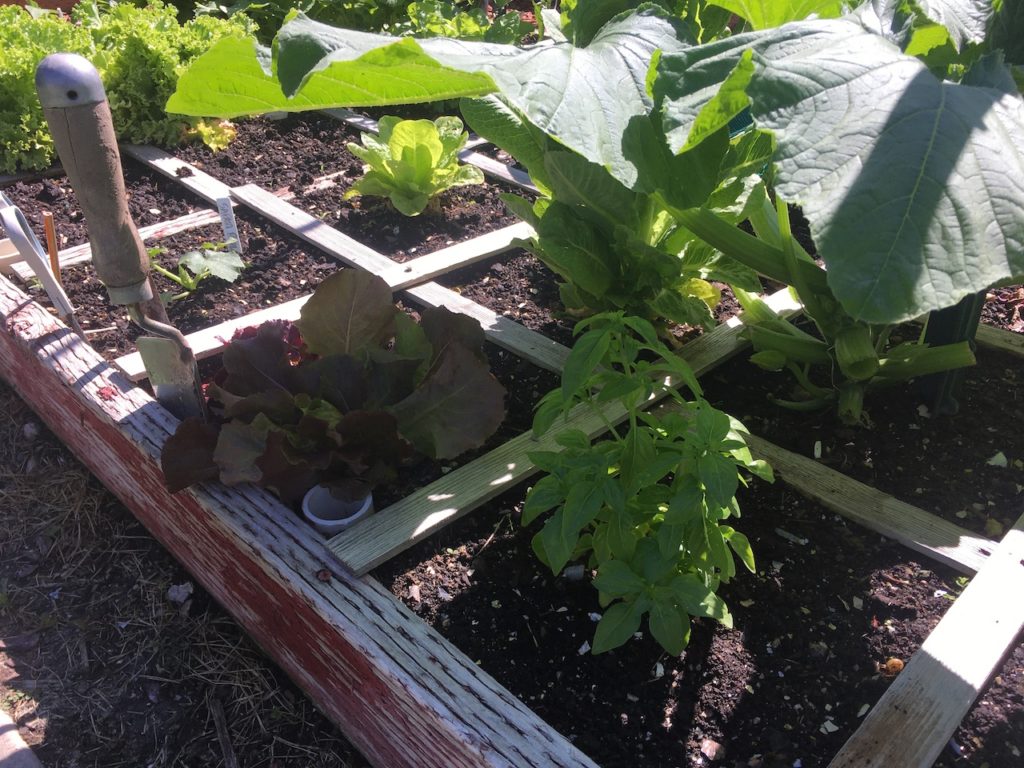 I’ve been growing zucchini vertically for years in my square foot garden. All vining crops are grown on trellises to save room, and to also provide better air circulation and sunlight. You know that zucchini leaves can get very large. As long as you have things that can get some sunlight you can use those larger leaves as a shade cover to cool down the soil for crops that don’t normally like the extreme temperatures we get. I’m able to get good morning sun on this lettuce, and then the larger leaves shade it for the hottest part of the afternoon, Combined with 3 or 4 other tricks, you can grow lettuce all summer long no matter where you live. We have temperatures in the high 90’s and even low 100’s every year. My ebook is right over there on the blog if you want to learn more about growing lettuce in the hot summer months.
I’ve been growing zucchini vertically for years in my square foot garden. All vining crops are grown on trellises to save room, and to also provide better air circulation and sunlight. You know that zucchini leaves can get very large. As long as you have things that can get some sunlight you can use those larger leaves as a shade cover to cool down the soil for crops that don’t normally like the extreme temperatures we get. I’m able to get good morning sun on this lettuce, and then the larger leaves shade it for the hottest part of the afternoon, Combined with 3 or 4 other tricks, you can grow lettuce all summer long no matter where you live. We have temperatures in the high 90’s and even low 100’s every year. My ebook is right over there on the blog if you want to learn more about growing lettuce in the hot summer months.

